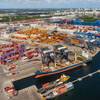Oakland Port: Big Drop in Greenhouse Gases
Oakland International Container Terminal (SSA), a major Port of Oakland tenant, said its $6 million conversion to hybrid yard cranes would cut greenhouse gas emissions 96 percent.
“This is way better than we thought it would be,” said Ken Larson, Crane Manager for the terminal’s parent company, Seattle-based SSA Terminals. “So far, this is a very successful project.”
The marine terminal, which handles 61 percent of Oakland’s cargo, is converting 13 massive cargo handlers, known as rubber tired gantry cranes, from diesel to battery-powered hybrid engines. The 90-foot-tall cranes combine to lift about 1,000 containers a day.
Three yard cranes have been retrofitted and returned to service since March, the terminal reported. The remainder will be done by next June. The big revelation so far: a dramatic drop in fuel use.
“The old engines burned 10 to 12 gallons of diesel an hour; the new ones…about a half-gallon per hour,” explained Larson. “That’s the nuts and bolts of air emission savings right there and we’re astonished by the results.”
SSA said hybrid engines would cut about 1,200 metric tons of greenhouse gas emissions annually from each crane. It said there would also be a 95 percent reduction in diesel particulate matter emissions.
The hybrid conversion project is being watched closely by maritime officials. Rubber tired gantry cranes are the workhorses of marine terminals where ships dock. They straddle mile-long rows of containers, lifting boxes on and off trucks and have 50-ton lift capacities. Reducing exhaust from the ubiquitous cranes could help the industry meet clean air commitments.
SSA is replacing 1,000-horsepower diesel engines on its cranes with 142-horsepower diesel hybrids. The new power plants include small diesel engines used only to charge a crane’s batteries. The Bay Area Air Quality Management District awarded SSA a $5 million grant to help finance the conversion.












